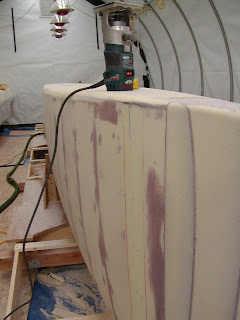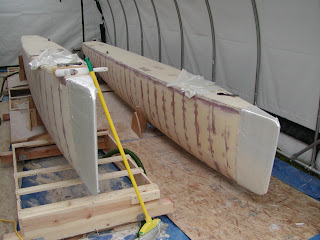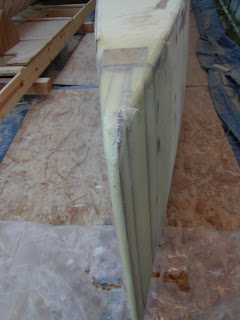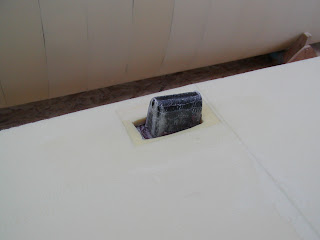After work today I was very motivated to get my bow caps laminated. At that point I still had not decided on whether to vacuum bag the float hulls or not, but figured that it would be a good idea to at least bag the bow caps, since they have lots of tricky curves.
First thing was to cut rebates for the bow cap glass. Based on some quicky testing and guesstimation, one or even two layers of 12oz glass do not require much of a rebate. So while I did cut rebates behind the bow cap on my starboard float...

...it is a very light rebate and you can hardly tell it is there. To be honest, I quickly started doubting the benefit of doing rebates for such a thin cloth and decided to skip this step on the port float.
After that, I started wrapping both bow caps with two layers of B cloth. This is quite the fun job; all I can say is thank you, thank you, for Raptor staples. Without those, and my wife lending some extra hands, I don't think you could wrap these bow caps in one step - you'd want to laminate one side at a time, e.g. with the float on its side. Here is the first layer on the starboard float:
 Looking pretty sharp, eh? Well, reserve final judgement until you see the back side:
Looking pretty sharp, eh? Well, reserve final judgement until you see the back side: I kept going like this until both float caps had two full layers of B cloth, with this being the final result at that stage:
I kept going like this until both float caps had two full layers of B cloth, with this being the final result at that stage:

The cloth is pulled especially taut around the leading edges, but in looking at this picture some of the other areas could have used a bit more tightening.
Next I mixed up some epoxy and started wetting out the cloth. While I was doing it I did things the old-fashioned way: pour a little resin on the squeegee, and then apply it to the cloth. You get a lot of drips and wasted epoxy this way (lay down a drop cloth or some plastic! - I forgot at first) and I now wonder if using a sponge roller would be more effective. Regardless though, I did make steady progress. Here is the port float all wetted-out:
 Another view of the port float:
Another view of the port float:

And one of the starboard float from the underside:

At that point, I should have wrapped it all up with peel ply and called it a night. Unfortunately I kept going and tried to vacuum bag both bow caps simultaneously, but it didn't turn out very well due to leaks. Read on for the gory details.
Earlier in the afternoon I had run a vacuum tube from the garage out to my boat tent, and I also had a "T" tube-fitting and some extra tubing, so that was all ready to go. But even with my wife helping me, I really underestimated how long it would take to get both bow caps all wrapped up in peel-ply+release film+breather+bag film (lots of odd shapes and corners to deal with), and I really underestimated how hard it would be to get a decent seal against the foam. Or I underestimated how hard it would be to get the bag pleats sealed - if anyone else tries this, I suggest making and testing your bag before you begin laminating. Anyway, here's what the setup looked like, when everything was all put together:
 When I started the pump it quickly became clear that I was far, far, from having a decent seal, and I never ever got more than 5 inches of vacuum. After futzing around for twenty minutes trying to find the leaks, I finally gave up and left it there for the night (with the vac pump off - there was no point leaving it on :). On the bright side I should have two fairly well laminated bow caps underneath all of that bag stuff -- I just need to go and dig them out tomorrow.
When I started the pump it quickly became clear that I was far, far, from having a decent seal, and I never ever got more than 5 inches of vacuum. After futzing around for twenty minutes trying to find the leaks, I finally gave up and left it there for the night (with the vac pump off - there was no point leaving it on :). On the bright side I should have two fairly well laminated bow caps underneath all of that bag stuff -- I just need to go and dig them out tomorrow.
I might be giving up too easy, but I think this experience has helped me decide: I'm not going to vacuum bag much else on this boat, except for critical or easy-to-bag parts. Bagging can be fun but it also takes a lot of time and work and I just want to get this boat done and go sailing.
By the way, when people ask me when I'll be done, I always say "in the water by Summer 2008". If they haven't seen the boat tent and the floats yet, they think that's a long way off and ask me if I'm sure it will take that long.. Once they see the floats, then they think I'm being optimistic. Go figure :).














































